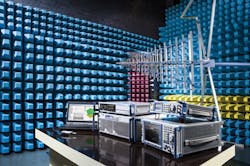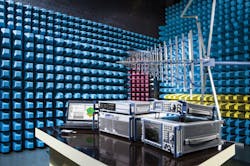Components, subassemblies aid EMC compliance
Courtesy of Rohde & Schwarz
The Test Instruments Special Report in this issue provides an in-depth look at amplifiers for EMC applications. And EMV 2016, held Feb. 23-25 in Düsseldorf, was a forum for exhibiting other instrument types. For example, Rohde & Schwarz showcased its R&S ESR EMI test receivers, which offer frequency ranges from 9 kHz to 3.6 GHz/7 GHz/26.5 GHz and can perform disturbance measurements in just a few seconds for standards-compliant EMC certifications. The company also highlighted its standardized R&S CEMS100 test platform—an off-the-shelf solution for radiated emissions measurements in line with IEC/EN 61000-4-3.
Also on display was R&S AdVISE (automated video inspection system for EMC), a video-based system for monitoring DUT reactions in automated EMC test environments. R&S AdVISE can complement an R&S EMC32 software-based system or operate as a standalone solution. Rohde & Schwarz also demonstrated the R&S BBL200 and R&S BBA150 from its broadband amplifier family; they cover power levels from 15 W to 10 kW in the frequency range from 9 kHz to 6 GHz.
When you apply such instruments to compliance or precompliance test, you hope that your products perform properly. To help ensure that they do, or to alleviate problems you find during test, you can employ components that help mitigate interference (such as chokes) or assemblies (such as power supplies) designed to meet emissions requirements.
In addition, you will want to ensure your devices are protected with regard to electrostatic-discharge events. Andrea Onetti, group vice president and general manager, Volume MEMS Division, STMicroelectronics, addressed this point with respect to the new interface IC for USB Type-C. “Knowing well the frustration of being surrounded by numerous different cables with very limited interoperability, ST, as a member of the USB-IF board of directors and an active player on the USB Implementers Forum, is working aggressively to build a strong and flexible portfolio of USB Type-C and power-delivery solutions that includes our STM32 microcontroller, ESD protection devices, and power-management products,” Onetti said. “The new STUSB16 family embeds higher levels of circuit protection and a customer-configurable nonvolatile memory, which enable IC configuration at power-up without software support.”
Following is a sampling of products that can help you meet emissions requirements while ensuring the safety of your devices.
New members of the Medline family include the OFM30 30-W (45-W peak) extra-low-leakage power supplies, which meet medical-system CF (Cardiac Floating)-class requirements, feature Class II double isolation, and are UL/IEC 60601-1 medically approved.
The vendor points out the difficulty of achieving low-leakage current while meeting EMC requirements, adding that the OFM30’s innovative design limits leakage current to less than 10 µA while achieving an EMC Class B average margin of 6 dB. Employing low-power-loss switching topology, the OFM30 Series has an efficiency up to 88%, fulfilling the Green Mode requirements of IEC 60950-1, CEC Level V, EISA, and ErP. Zero-load power consumption is below 0.3 W. The OFM30 series includes three models: OFM305025 delivering 12 V, the OFM305026 delivering 15 V, and the OFM305028 delivering 24 V. All products can be connected in parallel without any external components.
In addition, the Medline OFM225 225-W Series supplies, which meet BF (Body Floating)-class, now offer two more voltages: 12 V at 11.25 A (21.66 A peak) and 15 V at 6.66 A (19 A peak). Powerbox
The Top-Mount SuperSpeed Universal Serial Bus 3.1 Type C receptacle adds to the vendor’s line of USB I/O sockets. The USB 3.1 is 2x faster (up to 10 Gb/s) than USB 3.0 with more efficient data transfer, higher throughput, and improved I/O power efficiency. Features of the new receptacle include a USB 3.1 top-mount, hybrid layout; a full-metal housing with enhanced EMI/RFI prevention; and a reversible USB Type-C connector (which has no polarization so cables with Type-C plugs may be connected regardless of orientation). The socket maintains backward compatibility with previous USB versions and provides optimized power efficiency to reduce drain on portable device batteries. It supports storage, smartphone, tablet, notebook, docking, automotive, and home-entertainment applications.
The sockets come packaged on tape-and-reel, 550 parts per 13-inch reel. The vendor also carries the Mid-Mount SuperSpeed USB 3.1 Type-C sockets featuring a full metal housing with enhanced EMI/RFI prevention. Mill-Max
The new ESDALC5-1BF4 is a single-line ESD diode in a 0201 package, which sustains a 16-kV ESD surge. It combines a low parasitic capacitance of 12 pF with an efficient clamping voltage of 14 V just 30 ns after an 8-kV ESD discharge. A maximum leakage current of 100 nA helps minimize the overall system power consumption. The device’s bidirectional diode structure makes it compatible with positive and negative polarity signals. The 0201 surface-mount package, measuring only 0.3 mm x 0.8 mm, features a 16-kV capability and is suited for applications requiring a compact PCB form factor and strong ESD robustness. The devices are available from distributor Rutronik. STMicroelectronics
The new DKIH Series current-compensated chokes for PCB mounting are available for single- and three-phase applications with rated currents from 10 A to 50 A. The chokes are designed to suppress EMI noise caused by power applications on the PCB and, due to their open design, are lightweight and compact.
Like all other aspects of electronic design, the power portion often is built today using discrete components on PCBs. With the trending integration of components to achieve smaller and smaller form factors, thermal problems and high currents on the PCB can arise. It also becomes increasingly challenging to meet EMC requirements with a filter package due to the resulting space constraints; therefore, a filter on a PCB with discrete components is a good solution. The capacitors and a common-mode choke, with asymmetrical effective inductance, are very effective to dampen EMI noise.
The common-mode chokes are easily placed on the PCB with through-hole technology and designed and approved according to IEC 60938, UL 1283, and CSA 22.2 no. 8. The voltage rating is 300 VAC (IEC, UL), 250 VAC (CSA), and 425 VDC. Inductance ratings range from 0.30 mH to 0.90 mH. Schurter
The mechanical and electrical properties of beryllium copper make it the material of choice for EMI/RFI shielding products as well as for battery contacts, grounding clips, connector contacts, and ESD clips. The material provides shielding effectiveness over a broad frequency range. Tech-Etch’s in-house tool-and-die department offers bending capabilities for forming intricate sharp bends in tempers from annealed to full-hard. Component parts then are heat-treated in an inert atmosphere to enhance spring properties, permitting greater deflection without compression set while achieving close dimensional control. Finally, the company’s plating department can apply finishes including tin, silver, zinc, sulfamate nickel, electroless nickel, palladium nickel, and gold. The company offers precision engineered parts as well as a complete line of standard EMI/RFI shielding products. Tech-Etch
The DRF/HL DIN rail-mount power supplies are certified for use in potentially explosive atmospheres and marine applications. The products have been tested to ISA 12.12.01, IEC/EN 60079-0:2011, IEC/EN 60079-15:2010, and Guidelines for the Performance of Type Approvals—Test Requirements for Electrical/Electronic Equipment and Systems (VI-7-2). The 24-V output DRF/HL series is available in three power levels: 120 W, 240 W, and 480 W; they can deliver a peak power of 150% for four seconds. The overload characteristic is constant-current style suitable for driving motors and other nonlinear loads. The supplies operate from a universal input of 85 to 264 VAC (300 VAC for five seconds) and are compliant to EN 61000-3-2. Efficiency levels are as high as 94%, and standby power consumption is between <0.5 W and <0.75 W.
Housed in a metal enclosure, the DRF models offer slim case designs ranging from 36.5 mm to 82 mm in width, saving vital space on the DIN rail. All models share a common 123.4-mm height and 115.4-mm depth. In addition, they have been rigorously tested for shock and vibration while mounted on the rail. Additional safety certifications include UL 508 and IEC/UL/EN 60950-1 (2nd Ed.), and the supplies are CE marked in accordance with the LV Directive, the EMC Directive, and the RoHS2 Directive. The DIN rail power supplies meet EN 55022 and CISPR22 Class B for conducted and radiated EMI. TDK-Lambda Americas







